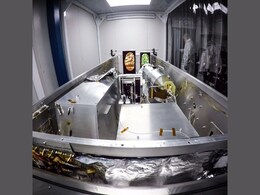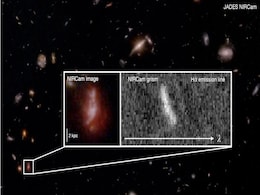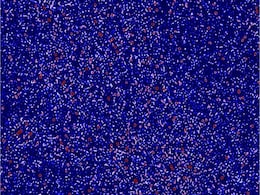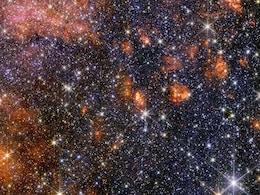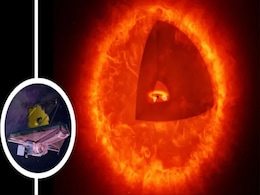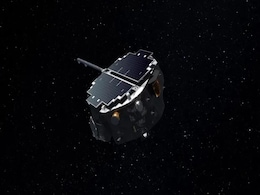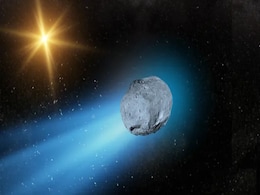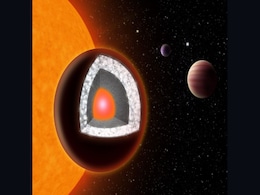Study Of Stars
- All
- News
- Videos
-

Scientists Inch Closer To Solving Cosmic Dust Mystery On Distant Star
- Wednesday December 3, 2025
- Science | Edited by Srishti Singh Sisodia
The discovery of Kappa Tucanae A's companion star provides a unique "laboratory" for studying hot exozodiacal dust.
-
 www.ndtv.com
www.ndtv.com
-

Seher Hone Ko Hai OTT Release: Cast, Plot, Trailer, Storyline, and Complete Drama Summary
- Monday December 1, 2025
- Written by Gadgets 360 Staff
The show has generated strong buzz online, with audiences praising its realistic theme and relatable mother–daughter bond. Discussions on social platforms revolve around its social message, powerful characters, and Parth Samthaan’s impactful presence.
-
 www.gadgets360.com
www.gadgets360.com
-

NASA Shares Highly-Anticipated Images Of 3I/ATLAS, Reveals Details Of Mysterious Interstellar Comet
- Thursday November 20, 2025
- Science | Edited by Srishti Singh Sisodia
3I/ATLAS offers a rare chance to study material that has travelled billions of kilometres because it originates from another star system.
-
 www.ndtv.com
www.ndtv.com
-

Supernova’s First Moments Show Olive-Shaped Blast in Groundbreaking Observations
- Sunday November 16, 2025
- Written by Gadgets 360 Staff
Astronomers captured the first moments of a nearby supernova, revealing an asymmetric, olive-shaped blast. In massive stars, core collapse after fuel exhaustion creates a shock wave. Early observations of future supernova surveys will be able to sample diversity in stellar explosions as well as the properties of broad breaks due to asymmetric sho...
-
 www.gadgets360.com
www.gadgets360.com
-

Nearby Super-Earth GJ 251 c Could Help Learn About Worlds That Once Supported Life, Astronomers Say
- Sunday November 16, 2025
- Written by Gadgets 360 Staff
Astronomers discovered GJ 251 c, a super-Earth 20 light-years away. Its location in the habitable zone and rocky composition make it a top candidate for future searches for life beyond our solar system. The team, led by Suvrath Mahadevan and Corey Beard, said this discovery provides a clock for one of the best candidates to search for life's atmo...
-
 www.gadgets360.com
www.gadgets360.com
-

Newly Found ‘Super-Earth’ GJ 251 c Could Be One of the Most Promising Worlds for Alien Life
- Sunday October 26, 2025
- Written by Gadgets 360 Staff
A new super-Earth, GJ 251 c, has been found orbiting a nearby red dwarf star within its habitable zone. About four times Earth’s mass, it may host liquid water. Detected via the radial-velocity method using Penn State’s Habitable Zone Planet Finder, it’s a prime target in the search for life.
-
 www.gadgets360.com
www.gadgets360.com
-

James Webb Telescope Finds Early Universe Galaxies Were More Chaotic Than We Thought
- Thursday October 23, 2025
- Written by Gadgets 360 Staff
The James Webb Space Telescope has revealed that galaxies in the early universe were far more chaotic and unstable than once believed. A new study shows that gas turbulence and intense star formation disrupted young galaxies, reshaping scientists’ understanding of how galaxies evolved into the structured systems seen today.
-
 www.gadgets360.com
www.gadgets360.com
-

Scientists Create Most Detailed Radio Map of Early Universe Using MWA
- Saturday October 18, 2025
- Written by Gadgets 360 Staff
Scientists using the Murchison Widefield Array in Australia analyzed nine years of radio data to study the elusive 21-cm hydrogen signal from the universe’s dark ages. Their findings suggest early black holes and stars had already heated cosmic gas, marking the first observational evidence of this warming phase.
-
 www.gadgets360.com
www.gadgets360.com
-

Deep-Sea Beryllium-10 Hints at Supernova Debris Reaching Earth 10 Million Years Ago
- Tuesday September 30, 2025
- Written by Gadgets 360 Staff
A new study has uncovered deep-sea evidence suggesting Earth may have been struck by debris from a nearby exploding star 10 million years ago. Scientists found unusually high levels of Beryllium-10 in Pacific crusts, consistent with a supernova origin. The findings could transform understanding of cosmic influences on Earth’s history, though terr...
-
 www.gadgets360.com
www.gadgets360.com
-

James Webb Telescope Unveils Hidden Star-Forming Regions in Sagittarius B2
- Wednesday October 1, 2025
- Written by Gadgets 360 Staff
New JWST observations reveal the hidden star-forming activity inside Sagittarius B2, the Milky Way’s largest molecular cloud. By seeing through dense dust, astronomers can study how stars form efficiently in extreme environments. These findings help explain not only Sgr B2 but also broader mechanisms shaping galaxies.
-
 www.gadgets360.com
www.gadgets360.com
-

Tiny Red Dots Spotted By NASA’s James Webb Telescope Could Be Black Hole Stars
- Thursday September 25, 2025
- Written by Gadgets 360 Staff
NASA’s James Webb Space Telescope revealed mysterious “little red dots” that seem too bright and mature for their age. A new study suggests they may be black hole stars—giant hydrogen spheres powered by black holes—helping explain the rapid growth of early supermassive black holes.
-
 www.gadgets360.com
www.gadgets360.com
-

Scientists Propose Space Missions to Chase Down Interstellar Comets
- Monday September 15, 2025
- Written by Gadgets 360 Staff
A Southwest Research Institute study reveals that chasing interstellar comets like 3I/ATLAS is achievable with current rockets and instruments. Such missions could collect data on comet nuclei and comae, providing clues to the formation of other star systems. International collaborations make these rare, high-value missions increasingly realistic.
-
 www.gadgets360.com
www.gadgets360.com
-

Scientists Say Missions to Interstellar Comets Like 3I/ATLAS Are Feasible With Existing Tech
- Wednesday September 10, 2025
- Written by Gadgets 360 Staff
A Southwest Research Institute study reveals that chasing interstellar comets like 3I/ATLAS is achievable with current rockets and instruments. Such missions could collect data on comet nuclei and comae, providing clues to the formation of other star systems. International collaborations make these rare, high-value missions increasingly realistic.
-
 www.gadgets360.com
www.gadgets360.com
-

Diamond 'Super-Earth' May Not Be Quite as Precious as Once Thought, Study Finds
- Monday September 8, 2025
- Written by Gadgets 360 Staff
New research challenges the idea that 55 Cancri e, once dubbed a “diamond planet”, is rich in carbon. Re-analysing telescope data, scientists concluded that the host star has a lot more oxygen than originally believed, making the possibility that its planet formed with a carbon-dominant atmosphere less likely.
-
 www.gadgets360.com
www.gadgets360.com
-

Scientists Inch Closer To Solving Cosmic Dust Mystery On Distant Star
- Wednesday December 3, 2025
- Science | Edited by Srishti Singh Sisodia
The discovery of Kappa Tucanae A's companion star provides a unique "laboratory" for studying hot exozodiacal dust.
-
 www.ndtv.com
www.ndtv.com
-

Seher Hone Ko Hai OTT Release: Cast, Plot, Trailer, Storyline, and Complete Drama Summary
- Monday December 1, 2025
- Written by Gadgets 360 Staff
The show has generated strong buzz online, with audiences praising its realistic theme and relatable mother–daughter bond. Discussions on social platforms revolve around its social message, powerful characters, and Parth Samthaan’s impactful presence.
-
 www.gadgets360.com
www.gadgets360.com
-

NASA Shares Highly-Anticipated Images Of 3I/ATLAS, Reveals Details Of Mysterious Interstellar Comet
- Thursday November 20, 2025
- Science | Edited by Srishti Singh Sisodia
3I/ATLAS offers a rare chance to study material that has travelled billions of kilometres because it originates from another star system.
-
 www.ndtv.com
www.ndtv.com
-

Supernova’s First Moments Show Olive-Shaped Blast in Groundbreaking Observations
- Sunday November 16, 2025
- Written by Gadgets 360 Staff
Astronomers captured the first moments of a nearby supernova, revealing an asymmetric, olive-shaped blast. In massive stars, core collapse after fuel exhaustion creates a shock wave. Early observations of future supernova surveys will be able to sample diversity in stellar explosions as well as the properties of broad breaks due to asymmetric sho...
-
 www.gadgets360.com
www.gadgets360.com
-

Nearby Super-Earth GJ 251 c Could Help Learn About Worlds That Once Supported Life, Astronomers Say
- Sunday November 16, 2025
- Written by Gadgets 360 Staff
Astronomers discovered GJ 251 c, a super-Earth 20 light-years away. Its location in the habitable zone and rocky composition make it a top candidate for future searches for life beyond our solar system. The team, led by Suvrath Mahadevan and Corey Beard, said this discovery provides a clock for one of the best candidates to search for life's atmo...
-
 www.gadgets360.com
www.gadgets360.com
-

Newly Found ‘Super-Earth’ GJ 251 c Could Be One of the Most Promising Worlds for Alien Life
- Sunday October 26, 2025
- Written by Gadgets 360 Staff
A new super-Earth, GJ 251 c, has been found orbiting a nearby red dwarf star within its habitable zone. About four times Earth’s mass, it may host liquid water. Detected via the radial-velocity method using Penn State’s Habitable Zone Planet Finder, it’s a prime target in the search for life.
-
 www.gadgets360.com
www.gadgets360.com
-

James Webb Telescope Finds Early Universe Galaxies Were More Chaotic Than We Thought
- Thursday October 23, 2025
- Written by Gadgets 360 Staff
The James Webb Space Telescope has revealed that galaxies in the early universe were far more chaotic and unstable than once believed. A new study shows that gas turbulence and intense star formation disrupted young galaxies, reshaping scientists’ understanding of how galaxies evolved into the structured systems seen today.
-
 www.gadgets360.com
www.gadgets360.com
-

Scientists Create Most Detailed Radio Map of Early Universe Using MWA
- Saturday October 18, 2025
- Written by Gadgets 360 Staff
Scientists using the Murchison Widefield Array in Australia analyzed nine years of radio data to study the elusive 21-cm hydrogen signal from the universe’s dark ages. Their findings suggest early black holes and stars had already heated cosmic gas, marking the first observational evidence of this warming phase.
-
 www.gadgets360.com
www.gadgets360.com
-

Deep-Sea Beryllium-10 Hints at Supernova Debris Reaching Earth 10 Million Years Ago
- Tuesday September 30, 2025
- Written by Gadgets 360 Staff
A new study has uncovered deep-sea evidence suggesting Earth may have been struck by debris from a nearby exploding star 10 million years ago. Scientists found unusually high levels of Beryllium-10 in Pacific crusts, consistent with a supernova origin. The findings could transform understanding of cosmic influences on Earth’s history, though terr...
-
 www.gadgets360.com
www.gadgets360.com
-

James Webb Telescope Unveils Hidden Star-Forming Regions in Sagittarius B2
- Wednesday October 1, 2025
- Written by Gadgets 360 Staff
New JWST observations reveal the hidden star-forming activity inside Sagittarius B2, the Milky Way’s largest molecular cloud. By seeing through dense dust, astronomers can study how stars form efficiently in extreme environments. These findings help explain not only Sgr B2 but also broader mechanisms shaping galaxies.
-
 www.gadgets360.com
www.gadgets360.com
-

Tiny Red Dots Spotted By NASA’s James Webb Telescope Could Be Black Hole Stars
- Thursday September 25, 2025
- Written by Gadgets 360 Staff
NASA’s James Webb Space Telescope revealed mysterious “little red dots” that seem too bright and mature for their age. A new study suggests they may be black hole stars—giant hydrogen spheres powered by black holes—helping explain the rapid growth of early supermassive black holes.
-
 www.gadgets360.com
www.gadgets360.com
-

Scientists Propose Space Missions to Chase Down Interstellar Comets
- Monday September 15, 2025
- Written by Gadgets 360 Staff
A Southwest Research Institute study reveals that chasing interstellar comets like 3I/ATLAS is achievable with current rockets and instruments. Such missions could collect data on comet nuclei and comae, providing clues to the formation of other star systems. International collaborations make these rare, high-value missions increasingly realistic.
-
 www.gadgets360.com
www.gadgets360.com
-

Scientists Say Missions to Interstellar Comets Like 3I/ATLAS Are Feasible With Existing Tech
- Wednesday September 10, 2025
- Written by Gadgets 360 Staff
A Southwest Research Institute study reveals that chasing interstellar comets like 3I/ATLAS is achievable with current rockets and instruments. Such missions could collect data on comet nuclei and comae, providing clues to the formation of other star systems. International collaborations make these rare, high-value missions increasingly realistic.
-
 www.gadgets360.com
www.gadgets360.com
-

Diamond 'Super-Earth' May Not Be Quite as Precious as Once Thought, Study Finds
- Monday September 8, 2025
- Written by Gadgets 360 Staff
New research challenges the idea that 55 Cancri e, once dubbed a “diamond planet”, is rich in carbon. Re-analysing telescope data, scientists concluded that the host star has a lot more oxygen than originally believed, making the possibility that its planet formed with a carbon-dominant atmosphere less likely.
-
 www.gadgets360.com
www.gadgets360.com







